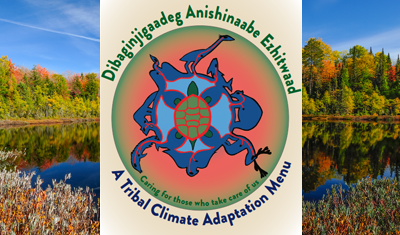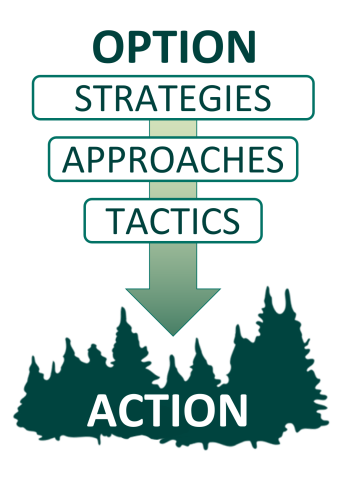Climate change has impacted and will continue to impact indigenous peoples, their lifeways and culture, and the natural world upon which they rely, in unpredictable and potentially devastating ways. Many climate adaptation planning tools fail to address the unique needs, values, and cultures of indigenous communities.

Overview
The Dibaginjigaadeg Anishinaabe Ezhitwaad Tribal Climate Adaptation Menu provides a framework to integrate indigenous and traditional knowledge, culture, language, and history into the climate adaptation planning process. It was developed by a diverse group of collaborators representing tribal, academic, intertribal, and government entities in the Great Lakes (Minnesota, Wisconsin, and Michigan).
This menu is designed to be used as a stand-alone resource, and it can also be used to supplement structured adaptation planning with the Adaptation Workbook process (published in Forest Adaptation Resources: Climate Change Tools and Approaches for Land Managers).
It also includes a companion guiding principles document, which describes detailed considerations for working with tribal communities.While this first version of the Menu was created based on Ojibwe and Menominee perspectives, languages, concepts, and values, it was intentionally designed to be adaptable to other indigenous communities, allowing for the incorporation of their language, knowledge, and culture.
Primarily developed for the use of indigenous communities, tribal natural resource agencies, and their non-indigenous partners, this Menu may be useful in bridging communication barriers for non-tribal persons or organizations interested in indigenous approaches to climate adaptation and the needs and values of tribal communities.

Strategies and approaches
The 14 strategies, 50+ approaches, and 100+ example tactics were developed through an assessment of existing adaptation tools, focus group discussions, and workshops with natural resource professionals.
Adaptation strategies are very general and can be applied in many ways across different ecosystems and cultural contexts. Adaptation approaches are more specific, describing in greater detail how strategies could be put into practice.
These strategies and approaches are designed to serve as stepping stones to allow natural resource managers and planners to translate broad concepts into targeted and specific actions (tactics) for putting climate change adaptation into practice to achieve a specific management objective in a specific location.
Example tactics are provided in the menu as illustrations of a few of the possible actions that could implemented for climate adaptation.
Even though this Tribal Climate Adaptation Menu is primarily designed to focus on natural resource management decisions, it includes strategies that are focused on relationships with other beings, the land, and the community. These concepts are deliberately presented first in the Tribal Climate Adaptation Menu to emphasize the importance of considering these relationships first and foremost.
Below is an example of how a climate change adaptation strategies, approaches, and potential tactics work together.
-
Example strategy: learn through careful and respectful observation (gikinawaabi).
Indigenous knowledges and ways recognize plant, animal, and other spirit beings as our original teachers.
While conventional land management favors direct intervention, with humans controlling the natural world, indigenous perspectives emphasize the importance of learning from other beings and natural communities.
This strategy involves taking time to observe and learn from the beings in a given area. This idea may become even more important in an era of climate change, as shifting conditions result in cascading ecosystem impacts and unexpected outcomes.
-
Example approach: learn from beings and natural communities as they respond to changing conditions over time.
With careful and patient attention, we can learn about strategic adaptation from the experiences and actions of plant, animal, and other spirit beings and natural communities.
This can include monitoring that acknowledges, respects, and learns from beings and natural communities. Learning patiently can be a valuable first step in situations with great uncertainty.
-
Example tactics
- Observe survivors of pest or disease outbreaks, droughts, and windthrow events to learn how they tolerated change and identify natural resistance to manidoonsag or other stressors.
- Establish a phenology monitoring program to observe changes in flowering dates, migration patterns, or other seasonal events.
- Seek out traditional ecological knowledge and scientific ecological knowledge on the life history and natural capabilities of beings to tolerate change.
- Observe shorelines and flood zones throughout lake level fluctuations or extreme weather events to understand new system dynamics.
- Observe bakaan ingoji gaa-ondaadag (non-local beings), their interactions with other beings, and changes to natural communities.
Dibaginjigaadeg Anishinaabe Ezhitwaad - A Tribal Climate Adaptation Menu
-
Approach 1.1. Consult cultural leaders, key community members, and elders.
Approach 1.2. Consider mindful practices of reciprocity.
Approach 1.3. Understand the human and landscape history of the community.
Approach 1.4. Hold respect for all of our relations, both tangible and intangible.
Approach 1.5. Maintain dynamic relationships in a changing landscape.
-
Approach 2.1: Learn from beings and natural communities as they respond to changing conditions over time.
-
Approach 3.1. Maintain and revitalize traditional relationships and uses.
Approach 3.2. Establish and support language revitalization programs.
Approach 3.3. Establish, maintain, and identify existing inventory and monitoring programs.
Approach 3.4. Establish and maintain cultural, environmental education, and youth programs.
Approach 3.5. Communicate opportunities for use of tribal and public lands.
Approach 3.6. Participate in local- and landscape-level management decisions with partner agencies.
-
Approach 4.1: Maintain or restore hydrology and soils.
Approach 4.2. Maintain or restore riparian areas.
Approach 4.3. Maintain or restore nibi (water) quality.
Approach 4.4. Support specific plants or plant communities with essential requirements.
Approach 4.5. Revitalize and maintain Anishinaabe/cultural use of ishkode (fire) as a stewardship tool.
Approach 4.6. Maintain and revitalize cultural approaches to harvesting and caretaking.
-
Approach 5.1. Maintain or improve the ability of communities to balance the effects of manidoonsag (little spirits).
Approach 5.2. Maintain or improve the ability of communities to balance the effects of bakaan ingoji ga-ondaadag (non-local beings).
Approach 5.3. Manage herbivory to promote regeneration of impacted beings.
Approach 5.4. Reduce negative impacts from anthropogenic disturbances.
Approach 5.5. Monitor and reduce ambient air pollution.
-
Approach 6.1: Alter community structure or composition to reduce risk or severity of major disturbances.
Approach 6.2. Promptly revegetate sites after natural disturbance.
Approach 6.3. Care for cultural sites after a severe disturbance.
Approach 6.4. Plan harvesting, gathering, and collecting opportunities to reduce the risk and impacts of disturbances.
-
Approach 7.1. Identify, prioritize, and maintain cultural sites and/or culturally sensitive areas.
Approach 7.2. Identify, prioritize, and maintain at-risk and/or culturally important beings or communities.
Approach 7.3. Establish places for at-risk or displaced beings outside of their normal environments (biological nests/refugia).
Approach 7.4. Seek out or share traditional and/or cultural knowledge to inform management of sensitive or at-risk beings or communities.
Approach 7.5. Create and/or maintain access routes to traditional gathering and harvesting sites.
Approach 7.6. Work across treaty or tribal areas with partners and other tribes to manage at-risk beings.
-
Approach 8.1. Maintain and restore diversity of native beings.
Approach 8.2. Promote diverse generations (both elder and younger beings).
Approach 8.3. Retain biological and cultural legacies.
Approach 8.4. Establish protected areas to maintain ecosystem and cultural diversity.
-
Approach 9.1. Manage habitats and access opportunities over a range of sites and conditions.
Approach 9.2. Identify additional lands for acquisition to expand the tribal land base, maintain diversity, and improve connectivity.
Approach 9.3. Reduce fragmentation to promote continuous natural ecosystems.
Approach 9.4. Maintain and create habitat corridors through restoration.
-
Approach 10.1. Use seeds and other biological material from relatives of beings from across a greater geographic range.
Approach 10.2. Favor local beings whose traits are better adapted to future conditions.
Approach 10.3. Collect and preserve seeds from beings that are at-risk or of concern to the community.
-
Approach 11.1. Favor or restore native beings that are expected to do well under future conditions and that can help meet future needs.
Approach 11.2. Establish or encourage new mixes of local beings and/or bakaan ingoji ga-ondaadag (non-local beings) expected to do well under future conditions to meet future needs.
Approach 11.3. Guide changes in composition of beings at early stages of development.
Approach 11.4. Seek out and share traditional and cultural knowledge of potential new beings from tribal communities where these beings are native.
-
Approach 12.1. Promptly prepare and revegetate sites after disturbance.
Approach 12.2. Allow for areas of natural regeneration to observe which beings naturally appear on the site.
Approach 12.3. Adapt significantly disrupted ecosystems to meet expected future conditions and needs.
Approach 12.4. Relocate ecosystems, beings, or cultural sites.
-
Approach 13.1. Reinforce infrastructure to meet expected conditions.
Approach 13.2. Incorporate natural or low impact development into designs.
Approach 13.3. Reroute, relocate, or remove infrastructure to increase access efficiency and minimize harmful impacts.
-
Approach 14.1. Plan for decreased streamflow and limited water availability.
Approach 14.2. Enhance the ability of ecosystems to retain water.
Approach 14.3. Adjust systems to cope with increased water availability and high water levels.
Approach 14.4. Respond to or prepare for excessive overland flows (surface runoff).
Approach 14.5. Adjust the location and size of forested areas to new or changing water levels.
Citation
Tribal Adaptation Menu Team. 2019. Dibaginjigaadeg Anishinaabe Ezhitwaad: A Tribal Climate Adaptation Menu. Great Lakes Indian Fish and Wildlife Commission, Odanah, Wisconsin. 54 p.
Acknowledgements
This Tribal Climate Adaptation Menu, which was developed by a diverse group of collaborators representing tribal, academic, intertribal and government entities in Minnesota, Wisconsin and Michigan, provides a framework to integrate indigenous and traditional knowledge, culture, language and history into the climate adaptation planning process. Developed as part of the Climate Change Response Framework, the Tribal Climate Adaptation Menu is designed to work with the Northern Institute of Applied Climate Science (NIACS) Adaptation Workbook, and as a stand-alone resource. The Adaptation Workbook process was published in Forest Adaptation Resources: Climate Change Tools and Approaches for Land Managers



